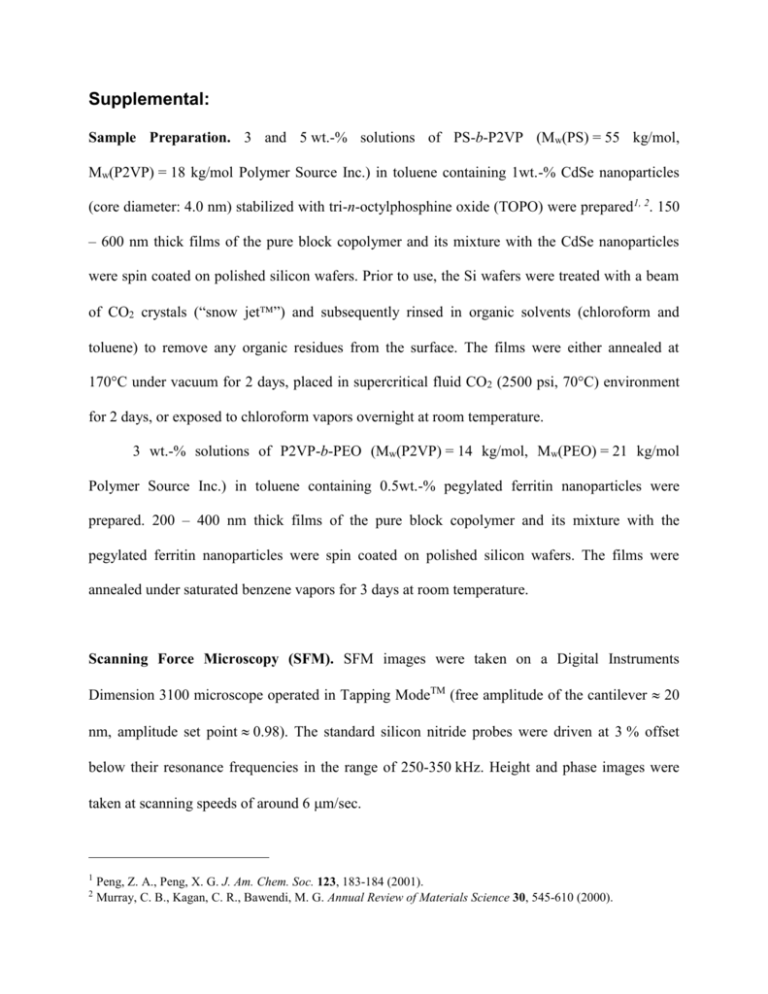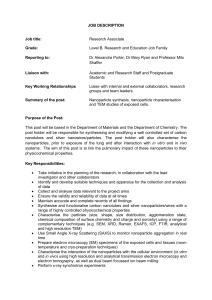Supplementary Data - Word file (4.1 MB )
advertisement

Supplemental: Sample Preparation. 3 and 5 wt.-% solutions of PS-b-P2VP (Mw(PS) = 55 kg/mol, Mw(P2VP) = 18 kg/mol Polymer Source Inc.) in toluene containing 1wt.-% CdSe nanoparticles (core diameter: 4.0 nm) stabilized with tri-n-octylphosphine oxide (TOPO) were prepared1, 2. 150 – 600 nm thick films of the pure block copolymer and its mixture with the CdSe nanoparticles were spin coated on polished silicon wafers. Prior to use, the Si wafers were treated with a beam of CO2 crystals (“snow jet”) and subsequently rinsed in organic solvents (chloroform and toluene) to remove any organic residues from the surface. The films were either annealed at 170°C under vacuum for 2 days, placed in supercritical fluid CO2 (2500 psi, 70°C) environment for 2 days, or exposed to chloroform vapors overnight at room temperature. 3 wt.-% solutions of P2VP-b-PEO (Mw(P2VP) = 14 kg/mol, Mw(PEO) = 21 kg/mol Polymer Source Inc.) in toluene containing 0.5wt.-% pegylated ferritin nanoparticles were prepared. 200 – 400 nm thick films of the pure block copolymer and its mixture with the pegylated ferritin nanoparticles were spin coated on polished silicon wafers. The films were annealed under saturated benzene vapors for 3 days at room temperature. Scanning Force Microscopy (SFM). SFM images were taken on a Digital Instruments Dimension 3100 microscope operated in Tapping ModeTM (free amplitude of the cantilever 20 nm, amplitude set point 0.98). The standard silicon nitride probes were driven at 3 % offset below their resonance frequencies in the range of 250-350 kHz. Height and phase images were taken at scanning speeds of around 6 m/sec. 1 2 Peng, Z. A., Peng, X. G. J. Am. Chem. Soc. 123, 183-184 (2001). Murray, C. B., Kagan, C. R., Bawendi, M. G. Annual Review of Materials Science 30, 545-610 (2000). Grazing Incidence Small Angle X-ray Scattering (GISAXS). The GISAXS experiments were performed at the 1-BM beamline at the Advanced Photon Source, Argonne National Laboratory, Argonne, IL. The operating wavelength was 1.05 Å. Images were recorded using a MAR CCD camera with a frame size of 2048 x 2048 pixels mounted behind a helium-flushed flight tube. Grazing-incident x-ray small-angle scattering (GISAXS) data (Figure 3) can be analyzed quantitatively to reveal the location of the nanoparticle aggregates with respect to the P2VP cylinders. Since the data are collected at various incident angles below and above the critical angle of the thin film (0.11°), depth-dependent information can be obtained. For example, Figure 3F shows the qz-line-scan curves as a function of moment transfer at the peak (1,0) (q y = 0.0131 Å-1) for different incidence angles. In order to obtain quantitative information about the distribution of nanoparticles within P2VP cylinder phase (i.e. the length of the nanoparticle rod within PVP cylinder), the curves in figure 3F can be fit using the following formula based on distorted-wave Born approximation3: I (q) ( ) 2 E ( ) E ( ) Fs (q) S s (q) Fc (q) 2 2 2 2 is the electron density difference between the matrix and the nanoparticles. and are the incidence and exit angles defined with respect to the surface. E() and E() are the transmitted and reflected electrical field amplitudes arising from dynamical effects. Fs(q) is the form factor of spherical nanoparticles and can be defined as: Fs (q) 4Rs 3 sin( qRs ) qRs cos( qRs ) exp( iq z Rs ) (qRs ) 3 where Rs is the average radii of the nanoparticles and q qx q y qz 2 3 2 2 Rauscher, M., Salditt, T., Spohn, H. Phys. Rev. B. 52, 16855-16863 (1995). Fc(q) is the form factor of cylinders and is defined as4: Fc (q) 2Rc H 2 J 1 (q // Rc ) sin( q z H / 2) exp( iq z H / 2) q // Rc qz H / 2 where Rc is the average radii of the cylinders, H is the average height of the cylinders, J 1(x) is the first order Bessel function and q // q x q y 2 2 Ss(q) is the structure factor of spheres and is defined as: 1 exp( 2q 2 d ) 2 S s (q) 1 2 exp( q 2 d ) cos(qd ) exp( 2q 2 d ) 2 2 Where d is the average separation between the nanoparticles and d is the width of the distribution in the average separation d. In the Supplemental Figure 1, a good fitting for the curve at incidence angle of 0.12º has been obtained. The mismatch at very low qz is probably due to the saturation of detector and also the effect of the dynamic scattering at low scattering exit angles. The fit becomes considerably better at higher qz (region of interest) and reveals the in the P2VP cylinders. These results prove that upon annealing, the nanoparticles migrate into P2VP cylinder block and mostly concentrate near the top surface region. Therefore the polymer/air surface Intensity (a.u.) nanoparticles are concentrated at about the top 380 Å 10 5 10 4 10 3 10 2 10 1 data calculation 0.05 0.10 0.15 qz (Å-1) energy is tuned by the self-assembly of nanoparticles. Supplemental Figure 1 4 Lazzari, R. J. Appl. Cryst. 35: 406-421 (2002). 0.20 Scanning Electron Microscopy (SEM). Secondary electron SEM was performed on unstained samples using a LEO 1530 field emission SEM with a lateral resolution of approximately 3 nm. For the images taken with the secondary electron detector, the acceleration voltage was 1kV or 3kV. For the images taken with the backscattering detector the acceleration voltage was 5kV. Oxygen Plasma Etching. The plasma etching was performed using a Harrick Plasma Cleaner PDC-32G operated at 60W with an oxygen pressure of 1 mbar. The etching rate for PS and PVP was monitored using homopolymer blends and was found to be 11 nm/min and 13 nm/min, respectively. For the PS microdomains and CdSe nanoparticle-rich PVP microdomains in the mixture of diblock copolymer/nanoparticles, the oxygen plasma etches approximately at the same rate of 12 nm/min. The samples were exposed to oxygen plasma from 1.5 to several minutes, with a controlled etching depth from 15 nm to 200 nm. After each etching step, SEM images were taken to monitor the microstructure and chemical composition inside the thin film5, 6. Supplemental Figure 2 shows a series of etching experiments imaged with different detector types. Images (A-C) are taken with a secondary electron detector at 3 kV and show the persistence of an array of hexagonal microdomains on the surface with an etching depth of 0, 70 and 135nm, respectively. The higher electron yield is attributed to the assembly of CdSe inside the PVP cylinders. In addition, the backscattering images (D-F) reveal that there exists a large electron scattering contrast between the cylinders and the matrix (PS) which is consistent with PVP cylinders being the CdSe-rich phase. At larger etching depth, the observed ordering is disturbed mainly due to the surface roughness originating from the isotropic etching characteristics of the oxygen plasma. Nevertheless, these real space results on the microdomain 5 6 Harrison, C. et al. Macromolecules 31, 2185-2189 (1998). Magerle, R. Physical Review Letters 85, 2749-2752 (2000). orientation clearly support the data obtained from GISAXS and TEM, i.e. that the cylinders are CdSe-rich and oriented perpendicular to the film surface and substrate interface. A C B A-C: SEM images of PS-b-PVP/nanoparticle film taken with secondary electron detector at 3kV acceleration voltage after subsequent oxygen plasma etching steps: (A) 0nm, (B) 70nm and (C) 135nm etching depth. Image size: 1 µm x 1µm. D E F D-F: SEM images of PS-b-PVP/nanoparticle film taken with backscattering detector at 5kV acceleration voltage after subsequent oxygen plasma etching steps: (D) 0nm, (E) 20nm and (F) 70nm etching depth. Image size: 1 µm x 1µm. Supplemental Figure 2 Transmission Electron Microscopy (TEM). The film surface was coated with a 10 nm carbon layer. After that the films were embedded in epoxy and cured for 12 hrs at 60 °C. Subsequently, the films were floated from the silicon wafer by dissolving the native silicon oxide surface layer with 48% hydrofluoric acid (HF).7 30 nm thick cross-sections were cut using a Leica Ultracut 7 We note that the observed contrast inversion in the TEM has been caused by the film treatment with HF. This was confirmed by control experiments on the pure PS-b-P2VP block copolymer. microtome equipped with a diamond knife. Bright field TEM was performed on samples stained with iodine using a JEOL 200CX electron microscope operated at 200 kV. Optical Microscopy. Optical microscopy images were performed with an Olympus BX-51 microscope with a DP70 digital camera. Synthesis of PEG-2000-NHS Ester. A mixture of polyethylene glycol monomethylether with an average molecular weight of 2000 g/mol (1.0 g, 0.5 mmol, from Aldrich), maleic anhydride (0.15 g, 1.5 mmol) and triethylamine (0.21 mL, 1.5 mmol) in dry dichloromethane (20 mL) was refluxed under nitrogen atmosphere overnight. After evaporation of solvent, the crude product was washed with dry diethyl ether (3×20 mL). Removal of the organic solvent and drying under high vacuum afforded a grey power, which was mixed with N-hydroxysuccinimide (27.4 mg; 0.24 mmol), N,N-dimethylaminopyridine (7.33 mg; 0.06 mmol) and DCC (60 mg, 0.29 mmol) in dry dichloromethane (10 mL). Then reaction mixture was stirring at room temperature under nitrogen overnight. After evaporation of solvents, crude product was washed with dry diethyl ether (3×20 mL). Removal of the solvents and drying under high vacuum afforded the product as a light brown sticky liquid, which was used in the following reaction directly. Synthesis of PEG-2000 Modified Horse Spleen Ferritin. Horse Spleen Ferritin (50 mg, from Sigma #F-4503) was added into 1×PBS buffer (10 mM phosphate, 150 mM NaCl, pH 8.5) to give a final volume of 18.6 mL. Then PEG-2000-NHS ester in DMF (40 mM, 1.4 mL) was added into above solution and the mixture was incubated for 24 h at room temperature. Upon ultracentrifugation at 42,000 rpm with Beckman 50.2 Ti rotor, a dark red pellet was collected and redissolved in 1×PBS buffer (2.0 mL) to afford a red solution of PEG-2000-Ferritin. For the final annealing experiments, another round of ultracentrifugation was performed. The pellet was rinsed with pure water (2×200 µL) and redissolved in pure water (2.0 mL). The final concentration of the PEG-2000-Ferritin is about 20 mg/mL. The integrity of the particles was confirmed by transmission electron microscopy (TEM) analyses, light scattering and sucrose gradient sedimentation and the diameter of the particles was determined to be 12 nm.






